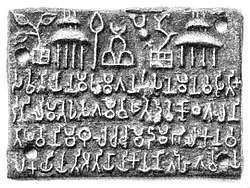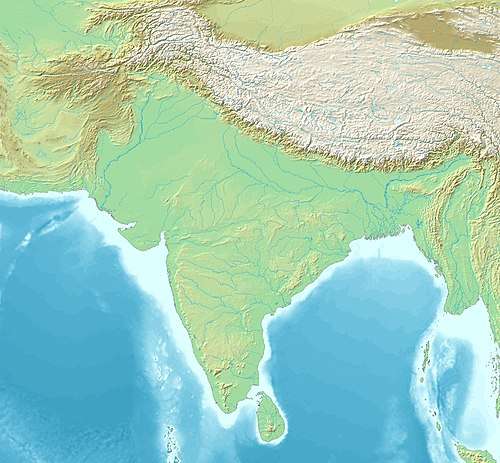Sohgaura copper plate inscription
The Sohgaura copper plate inscription is an Indian copper plate inscription written in Prakrit in the Brahmi script. It was discovered in Sohgaura, a village on the banks of the Rapti River, about 20 km south-east of Gorakhpur, in the Gorakhpur District, Uttar Pradesh, India.[1]
| Sohgaura copper plate inscription | |
|---|---|
 The Sohgaura copper plate. | |
| Material | Copper plate |
| Writing | Brahmi script |
| Created | 3rd century BCE |
| Period/culture | 3rd Century BCE |
| Discovered | 26.57°N 83.48°E |
| Place | India |
| Present location | Sohgaura |
 Sohgaura | |
The plate, consisting of a line of symbolic drawings and four lines of text, is the result of a molding.[2] The inscription is sometimes presented as pre-Ashokan, even pre-Mauryan, but the writing of the plate, especially the configuration of akshara would rather suggest a date after Ashoka.[2] Archaeologist Raymond Allchin believes it to be from Ashoka's period, and considers it to be a precursor of the later copper-plate inscriptions.[3]
The text of the plate has been translated as follows. Its mentions the establishment of two grain depots (Kosthagara) to fight against famine.[4]
Sāvatiyānam Mahāma(ttā)nam sāsane Mānavāsītika-
ḍasilimate Ussagāme va ete duve koṭṭhāgālāni
tina-yavāni maṃthulloca-chammā-dāma-bhālakān(i)va
laṃ kayiyati atiyāyikāya no gahi(ta)vvāya[5]At the junction called Manawasi,
these two storehouses are prepared,
for the sheltering of loads of commodities,
of Tiyavani, Mathura and Chanchu.— Translated by Fleet[2]
This is the oldest Indian copper plate inscription known.[3][4]
See also
- Indian epigraphy
References
- THE SOHGAURA COPPER-PLATE REGISTRATION BM Barua Annals of the Bhandarkar Oriental Research Institute Vol. 11, No. 1 (1930), pp. 32-48
- Sircar 1942 Select Inscriptions Vol 1 OCR p.85
- F. R. Allchin (1995). The Archaeology of Early Historic South Asia: The Emergence of Cities and States. Cambridge University Press. p. 212. ISBN 978-0-521-37695-2.
- 2000+ MCQs with Explanatory Notes For HISTORY by Disha Experts p.63
- Barua, B. M. (1930). "THE SOHGAURA COPPER-PLATE INSCRIPTION". Annals of the Bhandarkar Oriental Research Institute. 11 (1): 48. JSTOR 41688160.
| Edicts of Ashoka (Ruled 269–232 BCE) | |||||
| Regnal years of Ashoka |
Type of Edict (and location of the inscriptions) |
Geographical location | |||
| Year 8 | End of the Kalinga war and conversion to the "Dharma" |  Udegolam Nittur Brahmagiri Jatinga Rajula Mandagiri Yerragudi Sasaram Barabar Kandahar (Greek and Aramaic) Kandahar Khalsi Ai Khanoum (Greek city) | |||
| Year 10[1] | Minor Rock Edicts | Related events: Visit to the Bodhi tree in Bodh Gaya Construction of the Mahabodhi Temple and Diamond throne in Bodh Gaya Predication throughout India. Dissenssions in the Sangha Third Buddhist Council In Indian language: Sohgaura inscription Erection of the Pillars of Ashoka | |||
| Kandahar Bilingual Rock Inscription (in Greek and Aramaic, Kandahar) | |||||
| Minor Rock Edicts in Aramaic: Laghman Inscription, Taxila inscription | |||||
| Year 11 and later | Minor Rock Edicts (n°1, n°2 and n°3) (Panguraria, Maski, Palkigundu and Gavimath, Bahapur/Srinivaspuri, Bairat, Ahraura, Gujarra, Sasaram, Rajula Mandagiri, Yerragudi, Udegolam, Nittur, Brahmagiri, Siddapur, Jatinga-Rameshwara) | ||||
| Year 12 and later[1] | Barabar Caves inscriptions | Major Rock Edicts | |||
| Minor Pillar Edicts | Major Rock Edicts in Greek: Edicts n°12-13 (Kandahar) Major Rock Edicts in Indian language: Edicts No.1 ~ No.14 (in Kharoshthi script: Shahbazgarhi, Mansehra Edicts (in Brahmi script: Kalsi, Girnar, Sopara, Sannati, Yerragudi, Delhi Edicts) Major Rock Edicts 1-10, 14, Separate Edicts 1&2: (Dhauli, Jaugada) | ||||
| Schism Edict, Queen's Edict (Sarnath Sanchi Allahabad) Lumbini inscription, Nigali Sagar inscription | |||||
| Year 26, 27 and later[1] |
Major Pillar Edicts | ||||
| In Indian language: Major Pillar Edicts No.1 ~ No.7 (Allahabad pillar Delhi pillar Topra Kalan Rampurva Lauria Nandangarh Lauriya-Araraj Amaravati) Derived inscriptions in Aramaic, on rock: | |||||